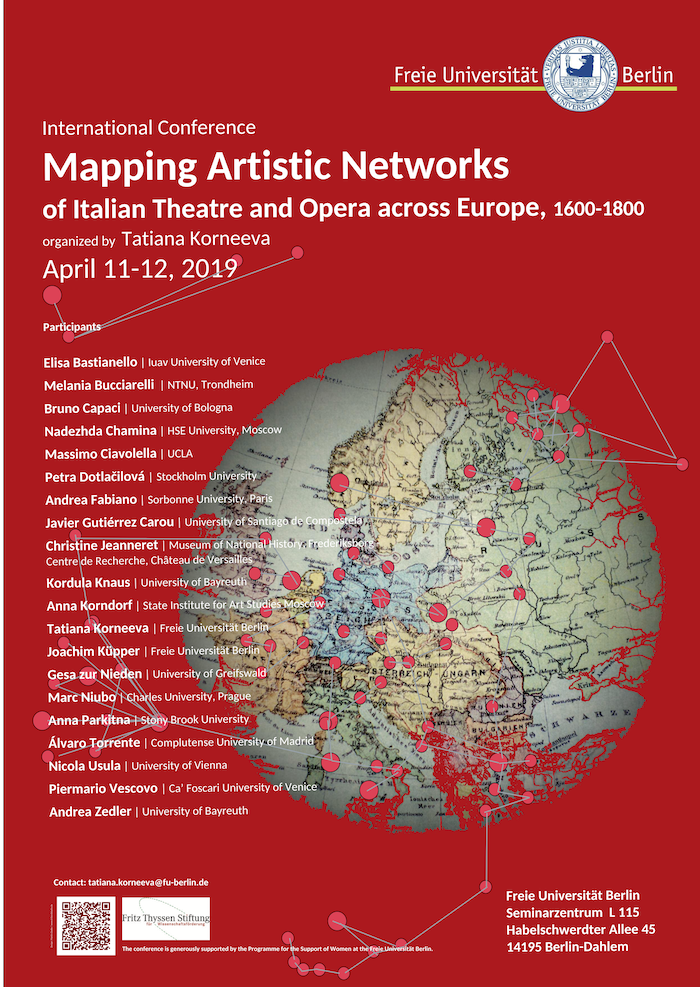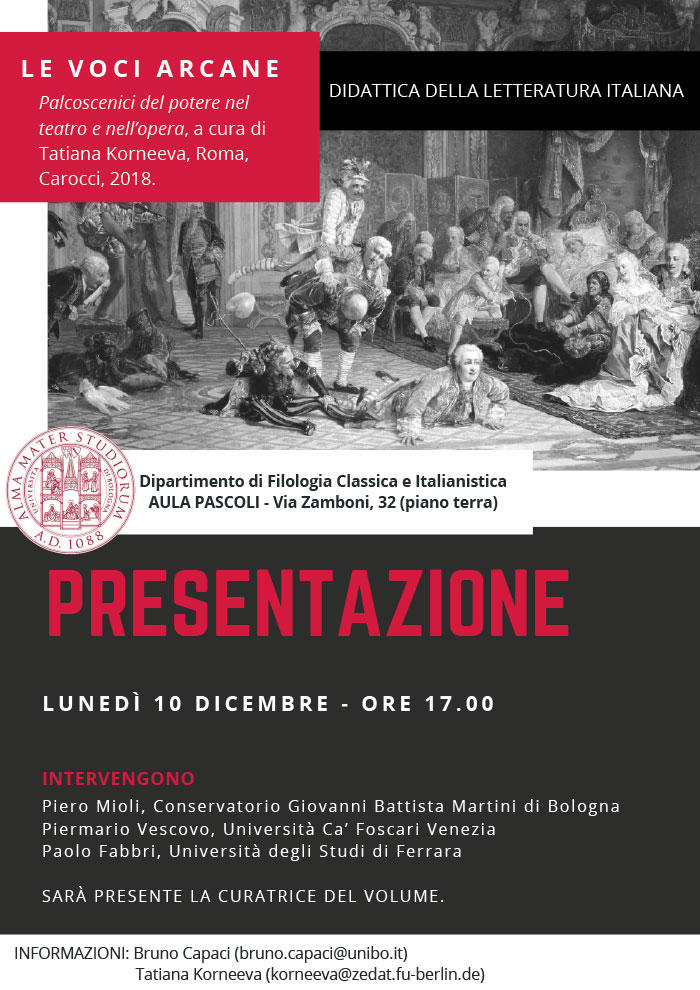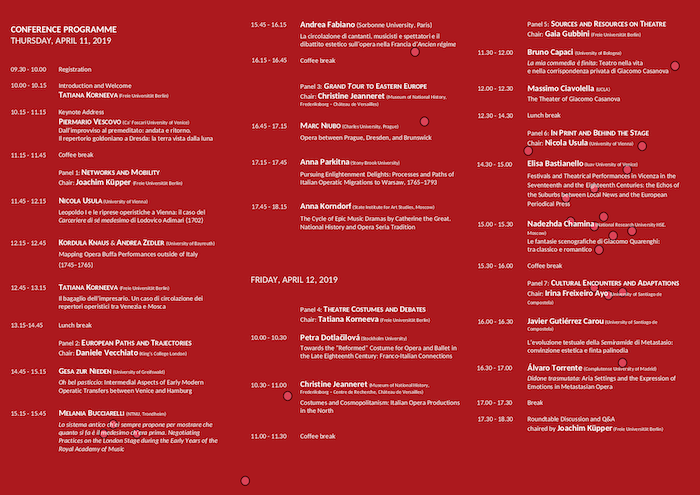Dr. Tatiana Korneeva

Fachgebiet / Arbeitsbereich:
Die Opera Buffa und die europäischen Höfe: Künstlernetzwerke und transnationaler Wissenstransfer von Dresden bis Sankt Petersburg (1750-1790). Forschungsprojekt gefördert durch die Fritz Thyssen Stiftung, Projektleitung.
Wissenschaftliche Mitarbeiterin
Sprechstunde
Bis Sommer 2021 beurlaubt.
Vita
Research Interests
Theatre and opera studies; Early Modern court culture and the public sphere; reception of classical tradition; Early Modern political thought.
Research Positions
- March 2018 – September 2018
Research Fellow at Centro Tedesco di Studi Veneziani (German Studies Center Venice)
- July 2017 – present
Principal Investigator for the project “Die Opera Buffa und die europäischen Höfe: Künstlernetzwerke und transnationaler Wissenstransfer von Dresden bis Sankt Petersburg (1750-1790)” funded by the Fritz Thyssen Stiftung.
- September 2016 – June 2017
Eurias Junior Fellow at the Institute of Advanced Studies of the Alma Mater Studiorum – Università di Bologna. Research project: “Staging the Empire: Italian opera seria at the Russian Imperial Court of Empress Elisabeth (1741–1762).” Funded by the European Commission under the Cofund Programme – Marie Curie Actions.
- April 2013 – March 2016
Research Associate (Wissenschaftliche Mitarbeiterin) in Comparative Literature at the Freie Universität Berlin for the European Research Council-funded project “Early Modern Drama and the Cultural Net (DramaNet).” Research Project: “Dramaturgy of the Spectator. Theatre, Audience, and the Public Sphere in Late Seventeenth- and Eighteenth-Century Italy.”
- November 2010 – October 2012
Postdoctoral Research Fellow at the Friedrich Schlegel Graduate School for Literary Studies, Freie Universität Berlin. Research Project: “Das Motiv der rivalisierenden Schwestern in der Literatur weiblicher Autoren (17.-19. Jh.): Vom französischen Märchen zum englischen Roman.” Supervisor: Prof. Dr. Joachim Küpper.
Education
- October 2004 – September 2007
PhD in Classical Languages, Linguistics, and History at the Scuola Normale Superiore di Pisa - September 1999 – June 2004
MA in Classical Philology and Comparative Literature at the ‘Lomonosov’ Moscow State University
Event Organization
- 19/06/2018
Organiser of the workshop Luoghi, attori e rappresentazioni del teatro italiano nell'Europa del Settecento at the Centro Tedesco di Studi Veneziani, Venice, Italy. - 25/05/2017 Organiser of the international workshop Le voci arcane. Palcoscenici del potere nel teatro e nell’opera tra Sette e Novecento, Istituto di Studi Avanzati – Alma Mater Studiorum – Università di Bologna.
- 26–27/10/2016
Organiser (with Prof. Dr. Joachim Küpper, Dr. Jaša Drnovšek) of the international conference History and Drama: The Pan-European Tradition, Freie Universität Berlin. - 27–31/08/2015
Organiser of a two-panel series “Marketing the Public: Targeting Strategies and Booktrade in the Long Eighteenth Century” at the 14th International Congress for eighteenth-century studies (ISECS) in Rotterdam (Netherlands). - 08–10/01/2014
Organiser (with Dr. Giacomo Mannironi) of a panel “Beyond the Carnival: Forms of Entertainment in Eighteenth-Century Venice” at the BSECS annual conference, St. Hugh’s College, Oxford. - 28-29/11/2013
Organiser (with Prof. Dr. Joachim Küpper, Dr. Kirill Ospovat, Dr. Katja Gvozdeva) of the international conference Dramatic Experience: Poetics of Drama and the Public Sphere(s) in Early Modern Europe and Beyond, Freie Universität Berlin. The conference proceedings volume is available via open access at Brill publishers online.
- PS "Italian Opera on Stage from Monteverdi to Verdi" (WS 2018 – 2019, Freie Universität Berlin)
- PS "From Libretto to Stage: Italian Opera in Performance“ (WS 2017 – 2018, Freie Universität Berlin)
- HS “Drammaturgia dello spettatore tra Sei e Settecento” (SS 2017, Alma Mater Studiorum – Università di Bologna)
- HS "Never-ending Short Stories in Literature, Theatre and Cinema“ (mit Igor Candido, SS 2016, Freie Universität Berlin)
- HS "Politics in Drama From Antiquity to Early Modernity“ (mit Fabio Pagani, SS 2015, Freie Universität Berlin)
- HS "Medea: Antiquity and Modernity“ (mit Fabio Pagani, WS 2013 – 2014, Freie Universität Berlin)
- PS "From the Page to the Stage: Theatrical Adaptations of Narrative Texts“ (WS 2012 – 2013, Freie Universität Berlin)
- PS "Storia della fiaba italiana“ (WS 2011 – 2012, Freie Universität Berlin)

International Conference
Mapping Artistic Networks of Italian Theatre and Opera across Europe, 1600-1800
Freie Universität Berlin, April 11-12, 2019
Convened by Tatiana Korneeva
Italian theatre of the seventeenth and eighteenth century was a truly European phenomenon, first because of the enduring popularity of the commedia dell’arte, and, at a later stage, of Goldoni’s reformed comedies and Italian opera. Secondly, its actors and musicians actively contributed to the circulation of ideas and cultural artefacts across geographical borders. Italian theatre was thus a true Erasmus programme of early modernity, as many celebrated playwrights, actors, impresarios, composers, librettists, and stage designers criss-crossed Europe and were employed at the courts of Paris, Vienna, Dresden, Warsaw, Prague, Copenhagen, and Saint Petersburg. If Europe was brought into being by the mobility of people and the circulation of ideas through theatrical performances, investigating the international careers of artists and the circulation of dramatic repertoires sheds light not only on the reception of Italian theatre but also on the cultural formation of Europe as a whole.
This conference addresses some of the key issues in the history of Italian theatre and opera, such as the transmission and reception of Italian dramatic genres outside of Italy and their adaptation to local cultures and tastes; the mobility and the routes of travel of theatre professionals and entrepreneurs; the world of theatre in the correspondences, memoirs, and periodical press as important sources for the reconstruction of careers and networks of actors, impresarios, singers, and operisti; and the impact of the artists involved in the production of performing arts on the European cultural heritage.
This broad variety of topics will be addressed with an eye for a truly transnational discourse and a balanced treatment of Italian theatre in a global performance history, while also trying to develop new terms and theoretical frameworks to address the issues of knowledge and cultural transfer.
Confirmed speakers: Piermario Vescovo (Ca’ Foscari University of Venice) - Keynote; Christine Jeanneret (HM Queen Margreth II’s Distinguished Fellow of The Carlsberg Foundation – Attachée au Centre de Recherche, Château de Versailles); Andrea Fabiano (Sorbonne University); Massimo Ciavolella (University of California, Los Angeles, UCLA); Javier Gutiérrez Carou (University of Santiago de Compostela); Álvaro Torrente (Complutense University of Madrid); Bruno Capaci (Alma Mater Studiorum – University of Bologna); Nicola Usula (University of Vienna); Gesa zur Nieden (Johannes Gutenberg University Mainz); Elisa Bastianello (IUAV University of Venice); Anna Korndorf (State Institute for Art Studies, Moscow); Melania Bucciarelli (Norwegian University of Technology and Science, Trondheim); Kordula Knaus (University of Bayreuth); Andrea Zedler (University of Bayreuth); Nadezhda Chamina (National Research University Higher School of Economics, Moscow); Marc Niubo (Charles University Prague); Anna Parkitna (Stony Broke University); Petra Dotlačilová (Stockholm University).

Die Opera Buffa und die europäischen Höfe: Künstlernetzwerke und transnationaler Wissenstransfer von Dresden bis Sankt Petersburg (1750-1790)
This project focuses on Italian opera buffa, a dominant mid-eighteenth-century phenomenon, and its place in politics and society as a paradigm for understanding processes of knowledge transfer across Western and Eastern Europe. The aim is twofold: first, to explore the role of opera buffa at the Russian, Austrian imperial, and other German courts as a means of investigating the complex semiotic exchange between absolutist politics and the arts, and this particular dramatic form’s more general impact on aesthetic practices and the emerging European public sphere. Second, to employ opera buffa – a widely disseminated art form that provides rich material for investigation into the cross-cultural circulation of art and into European systems of knowledge transfer – as a case study that permits the close examination of the complex cultural transfer of operatic repertoires, the mobility of artists, and the interaction of different dramatic genres in and among the European courts.
The Opera Buffa project is funded by Fritz Thyssen Stiftung under the supervision of Dr. Tatiana Korneeva at Freie Universität Berlin 2017-2019.
Book Project: The Dramaturgy of the Spectator: Theatre, Audience, and the Public Sphere in Late Seventeenth- and Eighteenth-Century Italy
How did spectators experience theatre at the dawn of modernity? How we can reconstruct, describe, and better understand the theatre audiences of the seventeenth and eighteenth centuries? What dramatic techniques did playwrights develop in response to the horizon of expectations of theatre-goers? How did public response, in turn, influence the production and circulation of dramatic works?How and why did audience members in this period gain visibility in discourse about theatre and become both a force of influence and a force worth influencing? When did audience response begin to rival the judgment of specialists and become the primary arbiter of the quality of theatrical performances? What theories on the role of the spectator were developed in eighteenth-century dramatic and aesthetic criticism?
The aim of this book is to provide compelling answers to these unresolved questions. By defining and delineating the formation and evolution of the Italian theatre public from the mid-Seicento through the late Settecento, this book pioneers a shift in the way we think about the audience as both theoretical concept and historical phenomenon. More specifically, this study investigates and then moves beyond spectatorship per se to explore and analyze its reflexive relationship with social and cultural politics in Italy, especially as they concern sovereignty, power structures, and the emergent public sphere.
Single-Authored Monograph
- The Dramaturgy of the Spectator: Theatre and The Public Sphere (1600–1800). Toronto-Buffalo-London: University of Toronto Press, 2019, 272 pages. https://utorontopress.com/ca/the-dramaturgy-of-the-spectator-2.
-
Alter et ipse: identità e duplicità nel sistema dei personaggi della Tebaide di Stazio. Pisa: ETS, 2011, 243 pages (review: Anke Walter, Bryn Mawr Classical Review, 03/2013 http://bmcr.brynmawr.edu/2013/2013-03-26.html)
Books Edited
-
Dramatic Experience: Poetics of Drama and the Public Sphere(s) in Early Modern Europe and Beyond, ed. by Katja Gvozdeva, Tatiana Korneeva, and Kirill Ospovat, Leiden-Boston: Brill, 2016. http://booksandjournals.brillonline.com/content/books/9789004329768.
-
Le voci arcane: Palcoscenici del potere nel teatro e nell’opera, ed. by Tatiana Korneeva, Roma: Carocci, 2018.
Articles in Peer Reviewed Journals and Edited Volumes
- “Refracting Translation zwischen Wien, Dresden und Moskau. Pietro Metastasios Clemenza di Tito im deutsch-russischen Kulturtransfer,” in Kreative Praktiken des literarischen Übersetzens um 1800. Übersetzungshistorische und literaturwissenschaftliche Studien, ed. by Alexander Nebrig and Daniele Vecchiato, Berlin: De Gryuter, 2018: 51–74.
- “Introduzione”, in Le voci arcane. Palcoscenici del potere nel teatro e nell’opera, ed. by Tatiana Korneeva, Roma: Carocci, 2018: 11-23.
- “L’una e l’altra clemenza. Le scene dell’impero di Elisabetta Petrovna e Caterina II”, Le voci arcane. Palcoscenici del potere nel teatro e nell’opera, ed. by Tatiana Korneeva, Roma: Carocci, 2018: 136-152.
- “The Art of Adaptation and Self-promotion: Carlo Gozzi’s La Principessa filosofa,” in Theatre Cultures within Globalising Empires: Looking at Early Modern England and Spain, ed. by Joachim Küpper and Leonie Pawlita, Berlin: De Gruyter, 2018: 40–58.
- “Introduction: Dramatic Experience: The Poetics of Drama and the Early Modern Public Sphere(s)”, in Dramatic Experience: Poetics of Drama and the Public Sphere(s) in Early Modern Europe and Beyond, ed. by Tatiana Korneeva, Kirill Ospovat, and Katja Gvozdeva, Leiden-Boston: Brill, 2016: 1–12.
- “Entertainment for Melancholics: The Public and the Public Stage in Carlo Gozzi’s L’Amore delle tre melarance,” Dramatic Experience: Poetics of Drama and the Public Sphere(s) in Early Modern Europe and Beyond, ed. by Tatiana Korneeva, Kirill Ospovat, and Katja Gvozdeva, Leiden-Boston: Brill, 2016: 140–171.
- “The Theatrical Politics and Political Theatre of Andrea Giacinto Cicognini,” in Politics and Aesthetics in European Baroque Tragedy, ed. by Jan Bloemendal and Nigel Smith, Leiden: Brill, 2016: 260–293.
- “Il ruolo del pubblico nella drammaturgia di Giacinto Andrea Cicognini e Carlo Goldoni,” in Goldoni «avant la lettre»: esperienze teatrali pregoldoniane (1650-1750), ed. by Javier Gutiérrez Carou, Venezia: lineadacqua, 2015: 503–512.
- “Il pubblico teatrale nel Genio buono e il genio cattivo di Carlo Goldoni,” in Italian Studies, 70.1 (2015): 92–116.
- “Desire and Desirability in Villeneuve and LePrince de Beaumont’s Beauty and the Beast,” in Marvels and Tales: Journal of Fairy-Tales Studies, 28.2 (2014): 233–251.
- “‘An old fairy tale told anew’: Victorian Fairy Pantomime.” Arabeschi. Rivista internazionale di studi su letteratura e visualità, 3, January–June 2013, http://www.arabeschi.it/anold-fairy-tale-told-anew-victorian-fairy-pantomime/
- “Law and Women’s Rights in Boccaccio’s Decameron: Madonna Filippa vs. Antigone,” in Comparatio: Zeitschrift für Vergleichende Literaturwissenschaft,Band 4, Heft 2 (2012): 225–238.
- “Rival Sisters and Vengeance Motifs in the contes de fées of d’Aulnoy, Lhéritier and Perrault,” in Modern Language Notes, 127.4 (2012): 732–753.
- “Cross-dressing Strategies in Benedikte Naubert’s Fairy-Tale Novella Der kurze Mantel,” in German Life and Letters, 65.3 (July 2012): 281–294.
- “La dimensione performativa della vendetta e della rivalità nei racconti di fate di d’Aulnoy e Lhéritier,” in Mantichora. Rivista di Studi sulle Arti Performative,1 (2011): 415–432. http://ww2.unime.it/mantichora/
- “Le ombre di Barbablù: la fiaba di Perrault nell’opera di Anna Achmatova e Ivan Bunin,” in eSamizdat, 6.1 (2008): 135–151, http://www.esamizdat.it/autori/korneeva.htm
- “Figure della duplicità e dell’ambiguità nel sistema dei personaggi della Tebaide di Stazio,” in Il personaggio: figure della dissolvenza e della permanenza – Character in Literature: Patterns of Evanescence and Permanence. Ed. by Chiara Lombardi. Torino: Edizioni dell’Orso, 2007: 231–241.
- “Il velo dell’indovino: ambiguità linguistica e aberrazione familiare nel sogno di Eteocle (Stat. Theb. II, 89–127),” in Studi Classici e Orientali, 50 (2004): 341–361.
Reviews
- Daniel Winkler, Körper, Revolution, Nation: Vittorio Alfieri und Das Republikanische Tragödienprojekt der Sattelzeit, Paderbon: Wilhelm Fink [Laboratorium Aufklärung], 2016, in Germanisch-Romanische Monatsschrift,67.2 (2017): 235-237.
- Gerhild Fuchs, Sabine Schrader, and Daniel Winkler, ed., Italienisches Theater. Geschichte und Gattungen von 1480 bis 1890, Berlin: Theater der Zeit, 2015, in Germanisch-Romanische Monatsschrift,66.4 (2016): 496–498.
- Enrico Zucchi, ed., “Mai non mi diero i dei senza un egual disastro una ventura.” La Merope di Scipione Maffei nel terzo centenario (1713–2013), Milano: Mimesis, 2015, in Drammaturgia (2015). http://drammaturgia.fupress.net/recensioni/recensione2.php?id=6367
- Carlo Gozzi, La donna serpente. Ed. by Giulietta Bazoli. Venezia: Marsilio, 2012, in Marvels and Tales: Journal of Fairy-Tales Studies, 28.1 (2014): 186–189.
- Hilary Brown, Gillian Dow, eds. Readers, Writers, Salonnières. Female Networks in Europe, 1700–1900. Frankfurt am Main: Peter Lang, 2011, in querelles-net. Rezensionszeitschrift für Frauen- und Geschlechterforschung,13.2 (2012). https://www.querelles-net.de/index.php/qn/article/view/1008/1036
- Bernd Fabritius, Rotkäppchen, was trägst du unter der Schürze? Geschlechterbilder im Märchen. Marburg: Tectum Verlag, 2010, in querelles-net. Rezensionszeitschrift für Frauen- und Geschlechterforschung, 13.1 (2012). https://www.querelles-net.de/index.php/qn/article/view/989/1007
- Hans-Heino Ewers, Erfahrung schrieb’s und reicht’s der Jugend. Geschichte der deutschen Kinder-und Jugendliteratur vom 18. bis zum 20. Jahrhundert. Gesammelte Beiträge aus drei Jahrzehnten. Frankfurt am Main: Peter Lang, 2010, in Marvels and Tales: Journal of Fairy-Tales Studies, 25.2 (2011): 388–390.
- Martin M. Winkler, Cinema and Classical Texts. Apollo’s New Light. Cambridge: Cambridge University Press, 2009, in Maia, 62.2-3 (2010): 461–464.
- Tamara Kataeva, Anti-Akhmatova. Minsk: Sovremennyj Literator, 2008, in eSamizdat, 7.1 (2009): 353–355. http://www.esamizdat.it/rivista/2009/1/recensioni/korneeva2.htm
- Pavel Sanaev, Seppellitemi dietro il battiscopa. Moskva: Ast, 2007, in eSamizdat, 7.1 (2009): 320–322. http://www.esamizdat.it/rivista/2009/1/recensioni/korneeva1.htm
- Randall T. Ganiban, Statius and Virgil. The Thebaid and the Reinterpretation of the Aeneid. Cambridge: Cambridge University Press, 2007; Charles A. McNelis, Statius’ Thebaid and the Poetics of Civil War. Cambridge: Cambridge University Press, 2007, in Prometheus, 33.3 (2007): 284–288.


